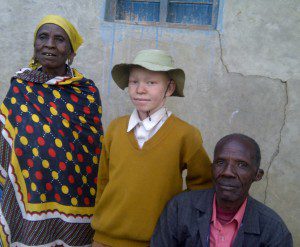Koert Lindijer has been a correspondent in Africa for the Dutch newspaper NRC since 1983. He is the author of four books on African affairs.

The Maasai boy Molle in 2009 and in 2014
A long high wall shields students of the elementary school Mwerereni from the cruel world outside. It is necessary because 35 out of its 620 student population are albinos. “That wall protects us from witchdoctors who want to chop albinos into body parts,” says the school Principal Damas Urengi in the Tanzanian town of Moshi. “Otherwise our children may fall prey to ritual sacrifice.”
Blind pupils, albinos and children with other serious skin diseases shuffle cautiously along the neatly swept paths under young trees. A special building equipped with screens that shield them from the pernicious bright light of the sun gives them solace. Bryan is an albino. Nurse Rose examines him in the school’s clinic. “There is nothing going on with you, you just ate too much,” she laughs. “We give our students extra care. And we teach them to love each other,” she explains. “So they will later become our ambassadors in a world full of hatred and superstition.”
For many albinos Africa is a curse; tortured by the sun and hunted in the shade. Because of their lack of skin pigmentation, which protects against ultraviolet rays, they quickly get skin cancer. The bright light cuts like a knife into their eyes. In Tanzania for instance, only 2 percent of albinos do grow older than forty years. A nurse at a clinic in Moshi says that since 2008, the dermatology department has surgically removed 500 deadly tumours from albinos.The hospital now provides free sunscreen.
Five years ago an alarm was raised over a series of murders of albinos in Tanzania and neighbouring countries. The Tanzanian government and international organizations swung into action and started to give protection with the police and sun creams. The situation has improved but organizations for albinos warn against the elections next year. During these elections the number of ritualistic killings of albinos can increase once more, because these modern day politicians also seek their fortune from witchdoctors otherwise known as medicine men.
Apart from the dangers posed by the sun, it is magic that makes albinos existence in Africa uncertain. For many Africans – whether they live in a slum or sit in parliament – spirits roam around freely everywhere. Magicians are to appease those spirits. Head teacher Damas says this superstition is due to ignorance and poverty. “Someone who is poor consults a medicine man and asks: ´how can I get rich´. He tends to believe the hocus-pocus”.
Shamans were once revered sages. A Kenyan Professor John Mbiti, in his authoritative book “African religions and philosophy“, calls them both doctor and priest: “In Africa illnesses and misfortunes are seen as the result of evil intentions of someone who uses magic or witchcraft. The medicine men in their own way provide psychological and physical solutions. “
This faith is deeply rooted, economic growth and modernization notwithstanding. Millions of traditional as well as skilled Africans still go to the medicine men that provide healing with herbs, offerings, or simply a good conversation. But where does herbal medicine stop and hocus-pocus begin? Quacks and charlatans also dabble into this sensitive profession. “Driven by greed they started offering pieces of albino body parts as medicine. In the past albinos were never slain for their limbs,” says Damas.
In Tanzania 2008 and 2009, seventy albinos were slain and their body parts processed into magic potions. As far as is known there are now fewer killings taking place in Tanzania, but the media still do report attacks.The problem has not gone away. The organization for albinos Under the Same Sun published a report in April 2014 indicating that over the last five years 133 albinos were murdered in 25 African countries. Under the Same Sun reports a case in the fast growing and modern capital city Dar es Salaam where two months ago the corpse of an albino man was found. His eyes were pierced; pieces of skin removed, and a hole in his stomach indicated that the assassins had targeted his internal organs too.
On the black market, arms, legs and genitals, easily fetch 50,000 Euros. Albino afterbirth can earn a thousand Euros. Corrupt medicine men mix the powder of albino bones or hair into creams, drinks and powders. Those remedies would supposedly ensure a miner of gold, a fisherman of a good catch, and a politician of an election victory.
“Previously parents anxiously hid their albino children in their home,” says teacher Dativa. “After the series of murders in 2009 however, parents began to send them to our protected school. We don´t allow them off the school grounds and we have employed four guards. Last year there was a failed attempt to abduct a child. For the albinos in particular we build dormitories. In holidays time they often don´t want to go home anymore, for fear of the dangers on the other side of the walls. “
Head teacher Damas brings the topic Ebola into the discussion. The same kind of superstition that feeds into the hunt on albinos is making the fight against ebola disease more difficult. Some West Africans believe that ebola is not a curse to combat, or that it is the white rescuers who brought the disease. “In Tanzania I learned as a child that albinos never die, for they are spirits,” says Damas. “Albinos were the spirits of the vile white settlers. That past combined with the practice of corrupt medicine men without conscience is causing the miserable fate of albinos. These days I hear that especially the limbs of children bring good luck, supposedly because the children are virgins, and they scream a lot when they are being amputated. This makes the potion or cream extra powerful. “
Some West African people believe albinos bring good luck. This belief is however not shared by all peoples. The pastoral people the Maasais in East Africa for example see albinos as a bad omen. “Why do you think you almost never see albinos with the Maasai?” asks the Maasai old man Samuel Miliyo rhetorically. “We kill them secretly immediately after birth.”
Samuel lives on the slopes of Mount Meru in Arusha. He built a kraal within which is a stone cottage, and in addition to his cows he also keeps chickens and grows corn. Thirteen years ago he rescued an albino boy he named Molle. “I do not live in a hut made of mud and cow dung anymore. My family is not so primitive,” he remarks sarcastically.
It is seven o’clock, almost dark, and the thirteen year old Molle is not home yet. His adoptive father Samuel points to the generous views of the savannah below. “There, at Mount Longido, we found the newborn Molle. Just before Maasais could kill him, because it is believed the baby would bring bad luck to everyone in the kraa. We had compassion on him.”
Then the exuberant Molle runs into the kraal. “He was playing football with his friends,” said Samuel. “A few years ago I would worry a lot about him being late. At that time children jeered at him and the elderly pointed fingers at him. Now Molle is a confident guy.”
Molle lifts the wide brim of his jungle hat and a big smile appears on his immaculate face. A few years ago that face was dotted with red spots and his eyes turned wildly around trying to focus.“I feel safe, I feel good,” laughs the boy. A few minor adjustments had worked wonders. His adoptive parents learned to smear sunscreen on his face, and good Samaritans had offered to pay his school fees. Molle remains aware however that he must be careful. “I never shake hands with strangers, and always stay close to my friends,” he says. “The elderly warn me that if I am not cautious I could be slain.”
Nearby residents still react confused to Molles presence. They wonder why Samuel got ‘this piece of bad luck ‘. “Two months ago, in a region not far away, attackers cut off an albino woman’s forearm. We must remain vigilant”, says Samuel Miliyo.
In the centre of the bustling city of Arusha, Soul Peace Mzee shows the office of his new consulting firm. He is an albino and full of confidence. Through his business success, he is widely accepted. “We have to crawl out of our shell and defend our interests,” he argues.
Out of disgust for the series of murders that occurred five years ago, he began a campaign to advocate for albinos. “Tanzania has more albinos than any other African country. But Tanzanians are so terribly superstitious. We discovered that some mothers kept their albino children hidden at home for upwards of fifteen years. In some parts of the country when I walk near restaurants, all the customers run away.” It is still a hell of a job to convince others that we are human beings, created in the image of God. “

